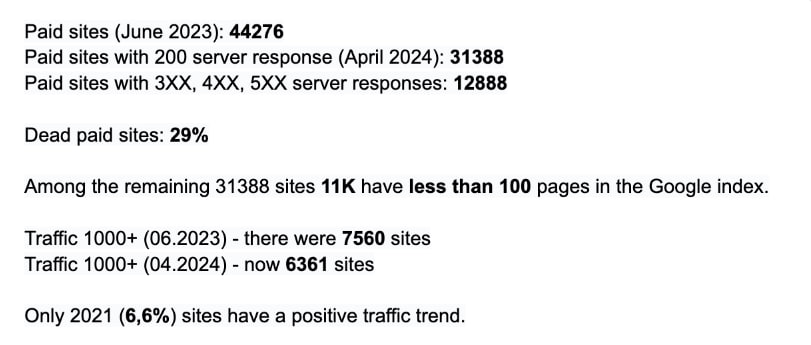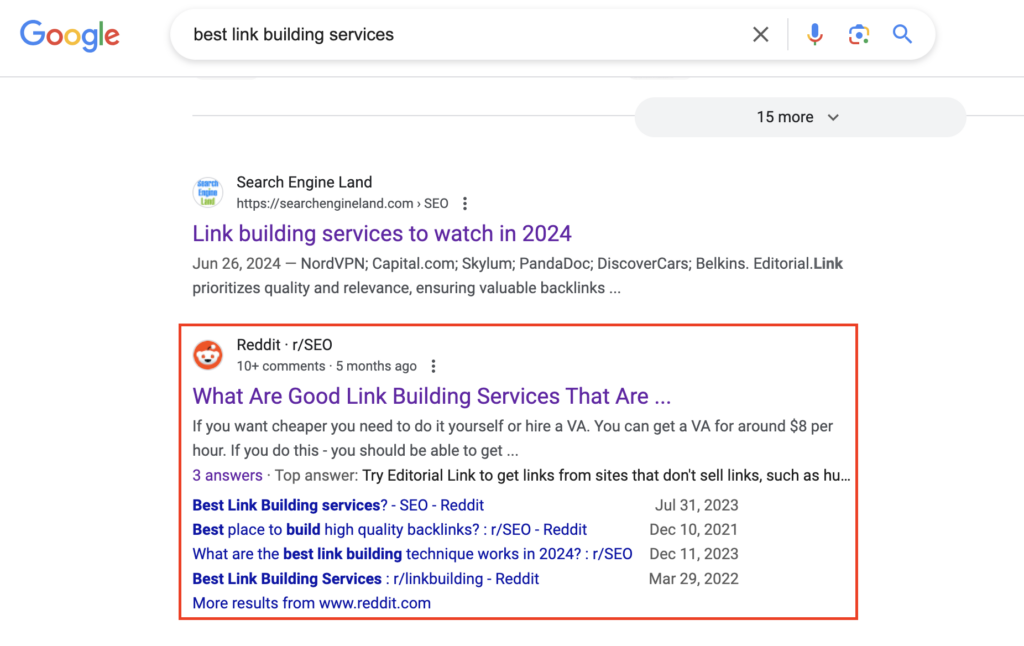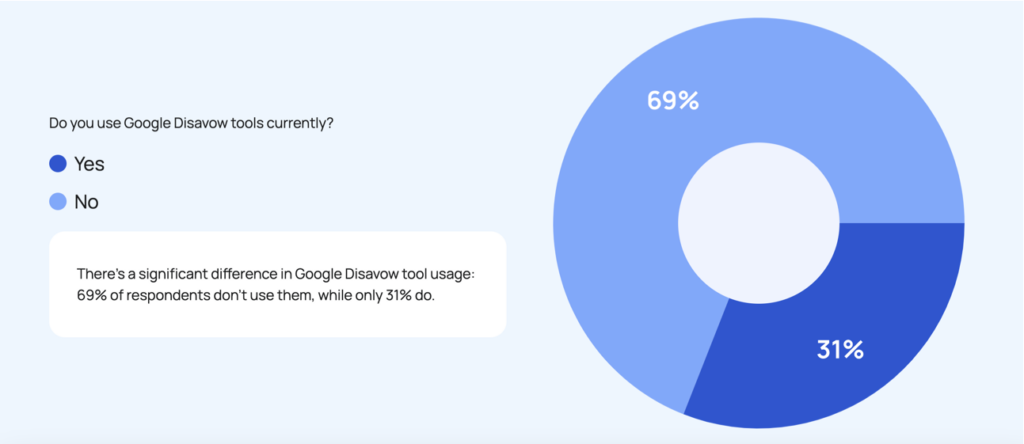“Not all links are created equal.” One of the biggest cliches in link-building.
But it’s true.
While some backlinks can boost your domain authority and improve SERP performance, others won’t make much impact and can even hurt your SEO results.
In the article, you’ll learn how to identify bad backlinks and prevent them from ruining your backlink profile.
Key takeaways
- Bad backlinks come from low-quality sources and can negatively impact search rankings.
- Key factors in assessing backlink quality include domain authority, relevance, spam score, traffic, and link placement.
- Avoiding bad backlinks is crucial because building them is a waste of your resources and can lead to penalties from search engines.
- Types of bad backlinks to avoid include paid links, forum/blog comment links, links from private blog networks (PBNs), low-quality directories, and spammy press releases, as well as hacked, hidden, and bot-generated links.
- Disavowing bad backlinks is generally unnecessary unless facing Manual action.
- Alternative white-hat link-building strategies include guest blogging, broken link building, leveraging unlinked brand mentions, creating linkable assets, and using HARO.
- To avoid wasting money and time on bad backlinks, work only with premium link-building services like Editorial.Link.
Bad vs. Good Backlinks
Bad backlinks are inbound links from low-quality sources like blog forums, spammy websites, or private blog networks (PBNs).
For example, here’s a link to the Ahrefs website from a low-DR e-commerce site selling a cannabis product.
While some Ahrefs users might be interested in this kind of product, the target audience overlap is minimal, so the link isn’t relevant.

Such links have no positive impact on your performance in search engine rankings and, in some situations, can affect them negatively.
Good backlinks, on the other hand, are relevant and come from authority sites.
For example, here’s a link to a law firm in a UK newspaper with a DR93, the Guardian.

Links from a site like this one increase your site authority in the eyes of search engines - and the readers. Over 11M readers from the UK visit the Guardian website every month. And this doesn’t include referral or paid traffic. These are all potential customers.

How to recognize bad links
We use a range of metrics and criteria to determine if we’re dealing with a bad backlink.
- Domain Authority (DA) / Domain Rating (DR) / Authority Score (AS): proprietary metrics from Moz/Ahrefs/Semrush based on the number and strength of inbound links. The higher the value, the more equity the link passes.
- Relevance: To improve SEO performance, the link needs to come from a site/page relevant to your niche or audience. Relevant links also bring targeted referral traffic to your site. According to the experts who took part in our State of Link Building study, this is the most critical metric.
- Spam / Toxicity Score: the metrics from Moz and Semrush assess the likelihood that a site is spammy based on factors like link patterns and site quality. A high spam score is a red flag.
- Traffic: Sites with significant traffic are generally more credible and provide better SEO value. To acquire links naturally, a website needs to have visitors. And through the link, their visitors can become your visitors.
- Link placement: Editorial links within the body of relevant, high-quality content are more valuable than links in footers, sidebars, or comments.
- Anchor text: Varied anchor text is preferred over the exact match, keyword-stuffed anchors, which can be a sign of manipulative linking practices.
- Inbound/outbound link ratio: A page with many outbound links may dilute the link's value to your site. Also, a large number of outbound links relative to inbound ones may mean the site is selling links.
- Dofollow vs. Nofollow: Nofollow links have more impact on rankings than initially believed, and a natural backlink profile includes both, but you still want the majority of your backlinks to be dofollow.
- Indexation status: The linking page and domain need to be indexed by Google. Otherwise, they don’t provide any SEO benefits.
- Website quality: Thin content or poor website design may indicate low authority.
💡 Pro tip: Don’t rely on a single metric because it can be misleading. For example, you can easily manipulate DR/DA by buying links. You will see this right away if you look at the website traffic, inbound/outbound link ratio, or the website content.
Why Avoiding Bad Backlinks Matters
Let’s face it: bad backlinks won’t get your page to the top 1 spot in SERPs.
And while they are easier and cheaper to get than quality ones, they still require your resources. So buying backlinks, adding your page to poor-quality directories, or spamming forums is a waste of time and/or money.
That’s what one of our clients found recently the hard way. They saw absolutely no results despite spending $50k a year on links. When we had a look at the links, it was clear they were all from a PBN.

So that’s 50k down the drain. And that’s the best-case scenario.
What’s the worst?
Manual penalty and deindexing.
Paying for links, excessive link exchanges, or building PBNs are all frowned upon by search engines which view them as attempts to manipulate rankings. And if they decide you’re taking the mickey and trying to play the system, things can get nasty.
That’s why people sometimes call such links toxic backlinks.
Google’s Approach to Detecting Spammy Links
Interestingly, Google has mechanisms to evaluate the quality of links by analyzing how many "trusted sources" connect to a page. Through a module in its system, referred to as IndexingDocjoinerAnchorSpamInfo, it appears Google factors in the endorsement of reputable, authoritative websites when assessing link quality.
While Google doesn’t define “trusted sources” explicitly, it likely considers factors such as domain authority, content reliability, and the site’s history of providing valuable information. Essentially, pages endorsed by credible websites are viewed as legitimate and less influenced by spammy links.
This means that even if your site acquires some low-quality or spammy links, the presence of links from highly regarded sources can act as a buffer, safeguarding your site’s reputation. Thus, building backlinks from reputable sites reduces the potential impact of bad links on your SEO performance.
9 Types of Bad Backlinks to Avoid
I’ve already explained what makes a lousy backlink and mentioned a few of their possible sources.
Let’s dive deeper into the main types of bad backlinks that you should avoid.

Paid links
Buying links is a direct violation of Google’s guidelines because it's aimed at manipulating search rankings.

So is selling them, and Google is very good at identifying such rogue sites.
This means that even if the link initially gives you a bit of a boost, the links will rot faster than quality ones.
We’ve recently studied over 44k sites known to be selling links, and after a year, 12k of them disappeared, while only just over 6.6K had 1000+ traffic.

How do you identify a link farm?
Common characteristics include poor content quality, lots of outbound links, and no clearly defined niche. Such websites have articles and ads on naughty topics, too. Like adult, dating, or gambling content.
You can also try our Link Type Classifier, a free tool that tells you how likely the website is to be selling links.

Forum and blog comment links
Links from forum threads and blog comments won’t get you far.
For starters, many forums and blogs block users from adding links, so your comments or posts may get flagged up as spam by default.
Even if you can post them, they normally come with the ‘nofollow’ or ‘ugc’ attribute, so they don’t pass any PageRank. Especially if the content is poor in the first place.
There are a couple of exceptions, though: Reddit and Quora.
Posting on these can help you increase your brand visibility and attract prospective customers.
How?
You’ve probably seen that they’ve been featuring high in SERPs after recent Google updates. Just check out this search result page for ‘best link building services’. A Reddit thread is in #2 spot.

PBNs
Private blog networks (PBNs) are systems of websites created to provide backlinks. They normally offer little value other than the links - usually to a few target pages owned by the same person.
That’s why building links from PBNs is considered a black-hat tactic.
Such websites often share similar designs. And just like link farms, they have little organic traffic and tons of outbound links. You can also identify them by looking at their IP address, which is often the same for multiple pages.
Low-quality directories
A quality directory, like Yelp or Clutch, can help you get new customers, and it’s definitely worth having your business listed there.
However, low-quality directories, often created exclusively for link-building purposes, are a waste of your time and resources.

Such directories lack editorial standards or relevance, offer poor user experience, and don’t inspire trust. This means that few people visit them, and consequently, you won’t be getting any qualified leads from there.
Hacked links
Hacked links are backlinks inserted into a website without the owner’s permission through unauthorized access or hacking.
They are often hidden within the site’s code or embedded in existing content, redirecting users to malicious or unrelated sites.
Now, imagine having a site with thousands of pages. How likely would you be able to spot such a link if it were added to one of them?
Hacking isn’t just unethical. It’s illegal.
There are two ways to avoid this:
Not doing it is one way. Obviously.
The other is vetting link providers. Dodgy links vendors may promise you a guest post or a niche edit but resort to hacking instead.
Hidden links
Hidden links are hyperlinks that have been intentionally hidden from the users but are still visible to search engine crawlers.
They do it by:
- Using the same color text and background
- Setting the font size to zero
- CSS positioning
- Using HTML attributes like display: none or visibility: hidden
- Placing links within a 1-pixel image or using negative text-indent.
Why would one bother to do it?
For example, to hide links from PBNs or link farms. Or to sell links on your website. A dishonest agency can hide links to other websites they work for in the content you’re paying for.
To find hidden links, you can manually inspect the page code, but this isn’t very efficient. Using SEO tools like Bing Webmaster Tools or Linxact may offer better results, but the results aren’t guaranteed.

Press release links
There’s nothing wrong with press releases as such. If you have newsworthy content about your company or product stories to share and send to relevant publications, that’s all kosher.
If the story gets picked up by a major news outlet or influential bloggers, you’ve hit the jackpot!
The problem is the press releases, whose main objective is getting links to manipulate rankings. You know, those packed with keyword-rich backlinks and then syndicated left, right, and center via spammy newswires.
This results in duplicate content filling the web, which doesn’t add value. Google sees press releases as adverts, and they won’t improve your SERP performance.
Widget links
Widgets are small applications or tools that can be easily added to a website, such as weather widgets, social media buttons, or site counters. To add value to the website and improve user engagement.
These widgets often include a backlink to the creator's website, typically in the form of a “powered by” or “developed by” link. That’s all good - by embedding the widget, you agree to link back to the site.
However, some widget builders use them as a medium to sell links.
These links are irrelevant, and the webmaster doesn’t have control over them, so they’re considered spammy backlinks, according to Google’s guidelines.
Bot links
Bot links are generated by automated programs designed to create backlinks at scale across various websites.
These bots typically target areas that allow user-generated content, such as comment sections, forums, directories, and blog posts, to place links quickly and in large quantities.
As a quick and effective way to gain hundreds of links, the tactic might be tempting.
But as you expect, such links don’t offer any SEO value because they come from low-quality pages and have a nofollow/UGC tag.
Disavow Or Not Disavow?
If you come across such backlinks to your site, you may be wondering if you should disavow them or let them be.
In general, I’ll go with the latter option, and I’m not the only one. 69% of the experts we interviewed for the State of Link Building report don’t see the need for it.

As mentioned, in most instances, Google simply dismisses such links, so there’s no need to worry about disavowing them.
John Mueller went even as far as saying that the concept of toxic links has been invented by SEO tools, supposedly to make us part with our money.

But what do Google’s internal records reveal?
While Google downplays "toxic links," internal documentation hints at a more nuanced reality. References to "BadBackLinks" in their records suggest that poor-quality links could, in fact, harm a page’s performance.
Though the exact workings are unclear, Google seems to use systems to classify and demote pages associated with spammy backlinks, part of their broader anti-link-spam efforts. This underscores the importance of proactively managing your backlink profile to avoid being flagged for associations with irrelevant or low-quality sites.
Does disavowing ever make sense?
Joshua Harwick of Ahrefs has recently conducted an experiment in which he disavowed backlinks that one SEO tool tagged as ‘toxic’ or ‘potentially toxic’.
The result? A 7% loss in organic traffic.

So don’t disavow.
Unless you have received a manual penalty or are at risk of receiving one. Or you know for sure that someone has been using dodgy practices to build links to your site.
Alternatives to Building Bad Backlinks
Let’s wrap up by looking at alternative approaches to link building that will be a better use of your time and money.
Using white-hat link-building tactics
If you’re building links in-house, stick to legit white-hat tactics.
Guest blogging
Guest posting involves writing high-quality, relevant content for other reputable websites in your industry.
In exchange, you get a backlink to your site, either in the author bio or within the content itself. Sometimes, multiple links.
This strategy helps you reach new audiences, build authority, and earn valuable backlinks from well-regarded sites.
Broken link building
Broken link building is a tactic where you find dead links on other websites within your niche and offer a replacement link from your site.
The idea is to provide value by helping the site owner fix a broken link while you gain a backlink in return.
This method is effective because it benefits both parties and often results in high-quality backlinks.
Unlinked brand mentions
Unlinked mentions occur when your brand, product, or yourself is mentioned on another website without a hyperlink back to your site.
Once you find such mentions, reach out to the site owner or editor and ask them to convert the mention into a clickable link.
As the site is already familiar with and has mentioned your brand, the chances of getting a backlink are higher. But it works only for well-known brands.
Creating linkable assets
Linkable assets are high-quality, valuable pieces of content specifically designed to attract backlinks.
They include:
- In-depth guides
- Original research
- Infographics
- Tools
- Interactive content
The key is to create something so valuable and unique that other sites naturally want to link to it as a resource. And to promote these assets, for example, through outreach and social media.
HARO link building
Helpareporter.com, Featured.com, and Help B2B Writer are services that connect writers with sources for their stories.
By signing up as a source, you can respond to their requests for expert opinions or information in your industry.
If your response is used, the journalist typically includes a backlink to your site in the article.
To increase your chances, make sure to offer unique insights and don’t bother with AI-generated responses.
Hire a reputable link-building services
The alternative to in-house link-building is working with a reputable link-building agency.
How do you choose one?
Here are a few tips:
- Look for a service with a history of successful, ethical link-building. Check case studies, testimonials, and reviews, and ask your partners for recommendations.
- Avoid services that are vague or secretive about their methods. Trust me, it’s not about protecting their trade secrets.
- Ensure they use only white hat techniques.
- Look for agencies offering strategies tailored to your specific industry and goals rather than a one-size-fits-all approach.
- Steer clear of services promising quick results or offer suspiciously low prices.
If that’s what you’re interested in, why not start looking for your perfect link-building agency by getting in touch with the Editorial.Link team?
Final Words
I started the article with one cliche, so let’s finish another one: In link-building, like in other areas, you get what you pay for.
Links from link schemes, like PBNs, link farms, or directories may be cheap to get, but their long-term impact on your SEO efforts is negligible. And in some cases, bad backlinks, for example, secured through hacking, can get you in serious trouble.
If you’d like help acquiring high-quality links from reputable sources that move the needle, Editorial Link can help! Get in touch!

